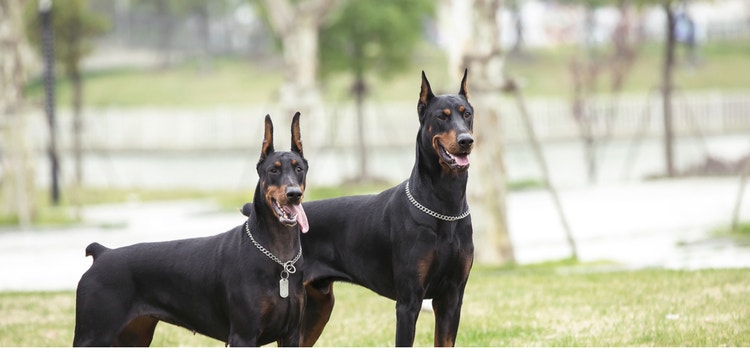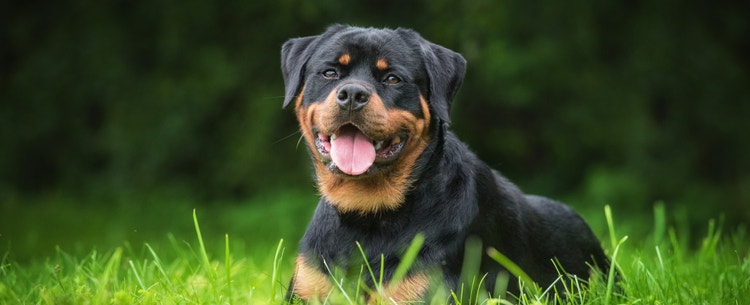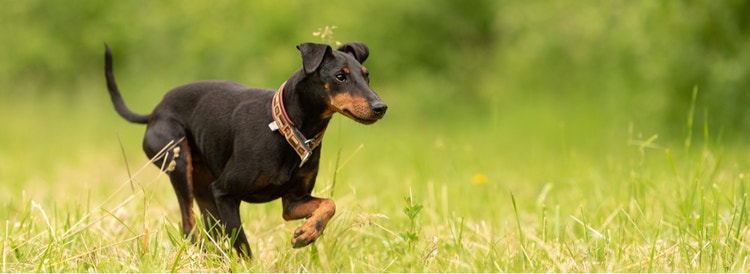
A Guide to Caring for a Doberman Pinscher


Where Are Doberman Pinschers From?
The Doberman breed originated in Germany in the late 1800s. A man named Louis Dobermann is recognized as the creator of the breed. They are a mixture of a Rottweiler, Black and Tan Manchester Terrier, German Pinscher, and German Pointer. It is said that Dobermann was a tax collector and wanted a fearless and aggressive guard dog to accompany him while he was doing his collection rounds. He also worked at a local animal shelter, which provided him with access to many different breeds, and the ability to quickly develop a new breed. By 1920, the breed was found throughout Europe, South Africa, and the United States.
Caring for a Doberman Pinscher
What Kind of Diet Does a Doberman Pinscher Need?
What Kind of Diet Does a Dobie Need?
Dobies require a balanced and high-quality diet to keep them healthy. They should be fed twice a day with a diet that includes a protein source as the top ingredient and whole grains as the second ingredient. If your Doberman is experiencing any digestive or skin problems, then you should consult with your veterinarian.
How Much Grooming Does a Doberman Pinscher Need?
How Much Grooming Does a Doberman Pinscher Need?
Dobermans are a short-haired breed that requires very little grooming and a monthly bath to keep their coats shiny. They’re moderate shedders, though their coats shed year-round and need to brushed out with a soft-bristled brush. Frequent brushing will also help reduce shedding overall and give their hair coat a nice sheen.
Are Doberman Pinschers Healthy Dogs?
Are Doberman Pinschers Healthy Dogs?
The breed has an average lifespan of 10 to 13 years but is predisposed to a number of illnesses and diseases. They should be screened for heart disease yearly, as this can be rather common for the breed. Gastric dilatation volvulus (GDV), commonly known as “bloat” or “torsion,” is also a life-threatening illness for Dobies.
Von Willebrand’s disease is an inherited bleeding disorder caused by a lack of the von Willebrand factor, which is a protein found in blood that is needed for appropriate blood clotting. Studies have determined that 70 percent of Dobermans are carriers for von Willebrand disease. Thankfully, they usually have a mild, clinical form of the disease.
Doberman Pinschers are predisposed to: von Willebrand’s disease, wobblers disease, gastric dilatation volvulus, dilated cardiomyopathy, hyperthyroidism, hip dysplasia, intervertebral disc disease, cataracts, entropion, alopecia, lick granulomas, diabetes, parvovirus, portosystemic shunts, chronic hepatitis, congenital deafness, lipomas, fibrosarcomas, and melanoma.
How Much Training Does a Doberman Need?
How Much Training Does a Doberman Need?
The Doberman is an extremely intelligent and obedient dog breed, making them highly trainable. You should start training between 6 and 8 weeks of age. They can be stand-offish with strangers and unfamiliar dogs, so it is important to socialize them at a young age. Positive reinforcement is an appropriate training method to utilize, since training should be a pleasurable for both dog and owner.
How Much Exercise Does a Doberman Pinscher Need?
How Much Exercise Does a Doberman Pinscher Need?
Dobermans are a high-energy breed. They need high-intensity activity for around 1 to 2 hours a day to keep a good body condition score. Rollerblading or bike-riding with your Doberman is a great way to exercise as a team.

Are You Ready to Adopt a Doberman Pinscher?
To adopt a Doberman puppy, start by making sure a dog of this size and demeanor will fit your lifestyle. Use our pet adoption checklist to walk through each step in the adoption process. Complete the necessary adoption applications and be prepared for interviews or home visits. Spend time with potential dogs to find a good match. Finally, prepare your home for the new pet, ensuring it's safe and welcoming.

Pet Insurance Options for Doberman Pinschers
Pet insurance for a Doberman Pinschers may help cover costs for conditions like lick granulomas and hip dysplasia. Consider a policy that includes hereditary and congenital conditions, flexible coverage options, and reasonable premiums.
Use our insurance aggregator tool to compare providers and find the best plan for your dog's unique needs.
What Are the Physical Characteristics of a Doberman Pinscher?
Doberman Pinscher Facts
Other Breeds to Explore
References
- American Kennel Club. The Complete Dog Book. Random House Digital, Inc., 2006.
- Morris, Desmond. Dogs: The Ultimate Dictionary of Over 1,000 Dog Breeds. Trafalgar Square, 2002.
- Wilcox, Bonnie and Chris Walkowicz. The Atlas of Dog Breeds of the World. T.F.H Publications, Inc., 1995.


